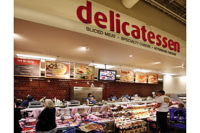The 2012 Deli Report






“More and more, the deli is becoming a food court, with diverse specialty stations or even a sit-down restaurant in some instances,” comments Jenny Anderson, director of research and consulting for Technomic Inc.
She notes that through the company’s interviews with consumers, shoppers have definitely taken notice of the made-to-order sandwich programs used by more and more retailers.
“That’s something where most retailers have the ingredients readily available, and offering freshly made sandwiches versus pre-made ones really enhances perceptions of the freshness for the overall department,” she says.
The deli section of the supermarket is, after all, competing directly with restaurants for the hungry-yet-undecided consumer. By providing something that they can take home, heat and eat, or even eat at the supermarket, deli departments are instrumental in keeping shoppers inside the supermarket instead of walking out to look for the nearest restaurant.
In its What’s in Store 2012 publication, the International Dairy-Deli-Bakery Association noted the popularity of ready-to-eat foods at the deli. The food is becoming more diverse to match the consumers’ ever-expanding palette. Deli pizzas, for example, are trending toward smaller-portion artisan pizzas with regional and ethnic flavors, and local produce for toppings.
“Whole-grain crusts, as well as all-natural, organic and vegetarian options are catering to the newly sophisticated American palette,” reports the IDDBA. Rotisserie chicken with flavors such as lime-cilantro and chipotle-barbecue, as well as chicken and turkey wings with signature sauces are also joining in on ethnic food trends.
Other food types that have proven appealing to customers looking for new meal solutions, according to the IDDBA, are chorizo sausage and carne asada, Korean short ribs, Polish kielbasa, carnitas and Serrano ham. As far as deli sandwich programs/prepared food areas, the trendiest ethnic items attracting shoppers include crepes, chipotle flavors, hummus, Korean BBQ and empanadas.
Shoppers looking for bolder flavors have also found it in the deli meat case. Boar’s Head this year introduced Boar’s Head Bold, a new line of globally inspired deli meats and cheeses. The line includes Jerk Turkey Breast inspired by Jamaica, Chipotle Chicken Breast inspired by the Baja Peninsula, 3-Pepper Colby Jack from Brazil, and Chipotle Gouda from Veracruz, Mexico.
Upon the products’ release earlier this spring, Boar’s Head president Michael Martella said the products “deliver a depth and complexity of flavor that’s a deli case first. With the trend in foreign travel and the popularity of ethnic foods, consumers have developed an appetite for complex flavor profiles. With our new line of Bold products, Boar’s Head is creating unique and delicious products that make international tastes convenient and accessible.”
Anderson points out that as retailers are taking their cues from restaurants and upscale markets such as Whole Foods, processors can be invaluable in helping them capture more frequent visits and meet consumer demands for freshness.
“Manufacturers are a tremendous resource in terms of providing learning in these areas, and products that help them meet the higher expectations for quality, along with speed of service demands and operational concerns and issues like food safety,” she says.
New and convenient
The deli area is a showcase area for new products, like the Boar’s Head Bold line. The IDDBA states that 82 percent of consumers enjoy visiting supermarket delis that feature newer and trendier items, regardless of whether they purchase these items or not. IDDBA recommends that delis cultivate an image of being “in the know,” so that consumers are more receptive to new products, trends and menu ideas.
Tyson Foods’ Deli division has picked up on that need with the addition of its Tyson Deli Market products, a new line of grab-and-go meals. They come in 16 different varieties, including wings, meatballs, chicken filets and pasta entrees.
“There has been tremendous growth in cold grab-and-go,” says T. FuQua, brand manager, who points out consumers are frequently making their dinner meal decisions after 5 p.m. “Consumers want food they typically can consume the same day they buy it.”
FuQua notes that research has identified only one in four supermarket shoppers as a deli customer, but those customers have the highest market basket ring and are the most driven by impulse. Price, on the other hand, is further down the list, though still a factor.
The Tyson Deli Market entrees promote convenience, so consumers can have a hot meal in as short a time as possible. The pasta entrees include Bacon, Vegetable Chicken Alfredo; Italian Mixed Grill; Meaty Mac & Cheese; and Cajun-Style Sausage Tortellini. The chicken filets are available Grilled or glazed with one of three flavors — Sweet Chili Glazed, Orange Teriyaki Glazed or Sweet BBQ Glazed. The wings come with Barbecue or Buffalo-style sauce or have a Roasted Garlic or Spicy Chipotle dry rub.
Tyson has, over the last four years, made a total commitment to the deli, FuQua says. Along with using research from external companies, the company interviewed millions of deli shoppers to understand their preferences. Because Tyson also provides products across the food continuum (including the foodservice sector), it can better understand consumer eating habits across all dayparts.
The boneless phenomenon, for instance, affects child consumers as well as their parents, so Tyson Deli has made a variety of boneless chicken products, from wings and popcorn chicken to Glazed Chicken Chunks. There is also an interest in products that are SNAP Card (Supplemental Nutrition Assistance Program — formerly Food Stamps) eligible, so the Tyson Deli Market entrees qualify.
“Many retailers would rather help customers with these products instead of candy bars [for the SNAP program],” says FuQua.
Prepared foods in the deli were, in the past, positioned as a convenient alternative to cooking, but more and more retailers are marketing them as an affordable alternative to dining out, says Technomic’s Anderson. To do that, she says, delis must continue to offer more than the homestyle dishes and deli staples of the past.
“They also need to be much more aware of contemporary food and concept trends, shifting consumer needs and demands relative to these trends, and things like health and wellness, value, convenience and more,” she adds.
“Consumers recognize advances in deli and, simply put, just expect more,” Anderson says. “They’ve been more exposed to the next generation of the supermarket deli as upscale supermarkets like Whole Foods and The Fresh Market expand to new markets, and major traditional supermarket chains have also revamped to deliver a better deli experience.
“They also remain highly value-conscious with the economy as it is, so they want to be satisfied with their purchases — both large and small,” she adds. “If they don’t, they’ll shift their dollars elsewhere. All of this is going to help drive ongoing advances in deli.”
Looking for a reprint of this article?
From high-res PDFs to custom plaques, order your copy today!









